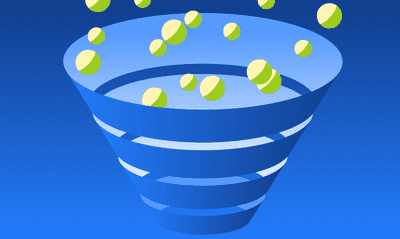What Is a Sales Pipeline and How to Create a Good One that Actually Works?
In this article, we will explore what a sales pipeline is and how you can best use it to manage your sales team, control the sales process, make accurate forecasting and turn opportunities into paying customers.
15 min read

Eric Hansen
Mar 11, 2021
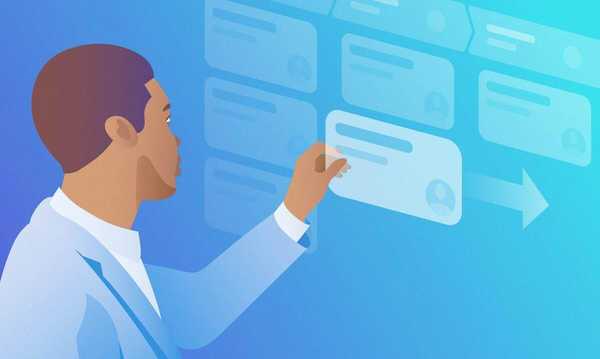
A sales pipeline is a crucial sales tool used in sale management and operation; it can make a significant difference to your bottom line. Often referred to as the deal pipeline, the sales pipeline provides an overview of the deals in your sale process, creating a more structured approach to sales. A sales pipeline is an effective tool for building and nurturing relationships; without it, you can run the risk of losing customers.
Many companies find that sales can be unpredictable, meaning their forecasting can feel quite off. A sales pipeline is also one of the best tools you can use for sales forecasting; nothing helps you understand the bigger picture better than a visual overview. The more visibility you have on your sales pipeline, the more control you have over the revenue that your business brings in.
What Is A Sales Pipeline
What Is A Pipeline
A pipeline in business refers to a flowing chain of events or processes, where a company takes a project from beginning to finish.
What Does Pipeline Mean In Sales
Like a pipeline in business, a sales pipeline is the process of moving opportunities from stage to stage until completion. The sales of a pipeline are often guided by your CRM, where the sales team can visualize the sales process and have an overview of what deals are in the pipeline.
A pipeline is a way of monitoring what stage each prospect is at, giving the sales team an overview of exactly where the money and deals are. As sales often involve juggling several opportunities at various stages, having a visual overview can be crucial in stopping a sale from falling through the cracks.
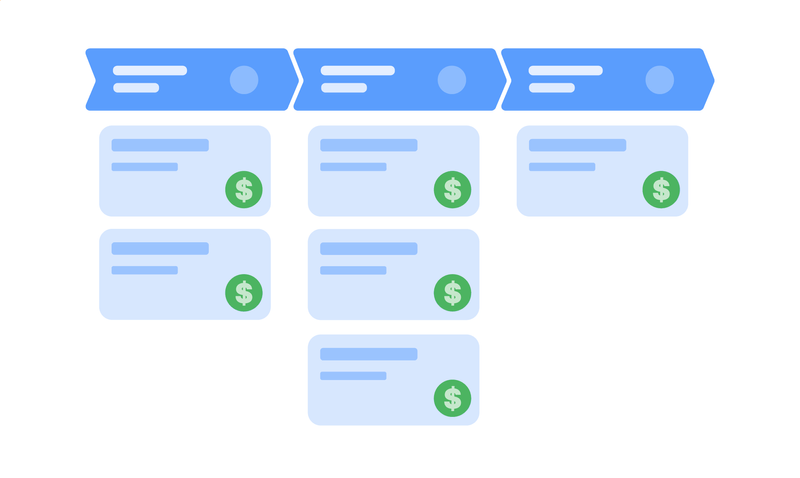
Along with giving an overview, a sales pipeline is also an excellent way for managers to gather data on their sales processes and sales teams’ progress. Greater visibility on the process enables the manager to analyze and adjust their approach to focus on the sales activity that is giving the greatest return; making a sales pipeline is one of the best tools for forecasting revenue.
While the overall goal of a pipeline is to move the opportunity from one stage to the next as quickly as possible, every journey should be unique and cater to the product or service you provide. Not all opportunities are created equal, and they will move through your pipeline at different rates; this can depend on a multitude of factors such as budget, interest, urgency, and timing.
While most often, the opportunity will simply move from stage to stage, and if they don’t proceed, they drop off the pipeline. There are certain cases where an opportunity can jump ahead in a stage in the pipeline; this may be a proactive opportunity that presents information upfront, enabling you to skip the qualifying stage.
Sale Pipeline Vs. Sales Funnel
Often people confuse sales pipelines with sales funnels. While both techniques are designed to generate income for the company, they target different types of customers. A sales pipeline is about deals, whereas a sales funnel about leads.
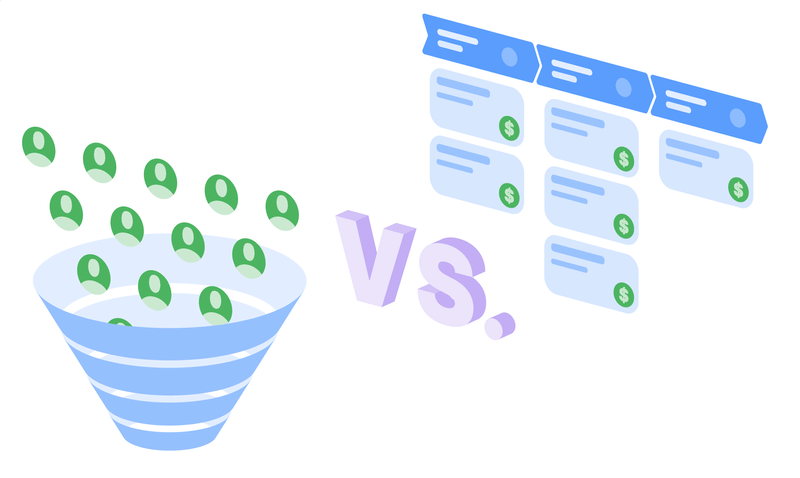
A sales pipeline refers to the stages that your sales team takes to move the deal through the process of starting to close. The sales funnel refers to the stages of the buying process that your lead goes from prospect to paying customer.
How To Build A Sales Pipeline
When building your sales pipeline, there are four key factors to consider; these key factors will help you to analyze your market and what is needed to build the most effective pipeline for your customer, your business, and your sales team.
However, it is important to recognize that the first pipeline you make may not be the final; building and maintaining a sales pipeline has multiple steps to continuously evaluate and update.
Identify Your Prospective Buyers
The first step is to define the characteristics of your ideal target customers and target businesses. Knowing who they are and their pain points will help you devise a plan on how you attract them and whether this is a bottom-up or top-down approach. Gathering this information is vital in helping you to create pipeline stages that are specifically tailored to your business needs and goals.
Identify Sales Pipeline Activities
Each stage in the pipeline should have activities to help the opportunity to move to the next stage. While sales activities will differ between deals, assigning specific tasks to each stage will give the sales team clarity and guidance as they move through the sales pipeline. Activities can range from phone calls to demos to follow-up emails; each process is different. It is important to identify what activities have worked for you previously and identify new activities you think will help achieve your goal. If you are new to sales, the best way to develop a process is by trial and error, analyzing what works, and building your sales activities around that.
Once you have decided on the activities you think would work for your sales process, then you can think about where to place them in the pipeline stages. You may use a certain activity only once in the sales process, or it may be one that you use to nurture your prospect throughout the course of the deal. For example, facilitating contact may involve activities such as phone calls or email, nurturing the relationship may include emailing content marketing materials such as newsletters, and the proposal stage may include doing a demo or a face-to-face meeting in which you need to book an appointment. Some activities may also involve including external teams such as marketing, engineers, or pricing specialists.
Define Your Sales Cycle Length
A sales cycle refers to the length of time that your sales team takes to close the deal. The length of a sale cycle can vary significantly between business and products. One of the most significant factors will be your product’s complexity, the more complex the product or service, the longer the cycle may be. This can be due to multiple teams and activities involved in the sales process, bigger budgets, customization, and more research needed to convince the buyer to choose your service.
The other key player in defining the sale cycle length is the source and quality of the leads. Typically, if your sales team is primarily focused on outbound leads via email or phone calls, it will take longer to convert a prospect to a customer; typically, sales cycles with inbound leads via website, social media, or referrals are much quicker to turn around and require less stage in the sales pipeline process.
Monitoring your sales cycle length will help you refine your sales process, understand what is successful, and see where you need more consideration and more resources.
Define Your Sales Pipeline Stages
Your sales pipeline is about managing the sales activities; effective management increases revenue, customer satisfaction and stops any deals from falling through the cracks. Sales pipelines can come in all different sizes depending on the complexity of the business, with the number of stages and activities in a sales pipeline varying based on your business needs and goals.
For some businesses, it can take just weeks to close a deal, meaning there are fewer stages needed to convert the lead to a customer. For those with more complex products, negotiations can take months, meaning a longer sales lifecycle and therefore more stages needed in the pipeline to cater for more external support and nurturing activities.
Ultimately your sales pipeline stages should represent each step that a prospect will take through your sales process to effectively convert from being a lead to a paying customer. In the next section, we will look at how to build a strong sales pipeline.
Sales Pipeline Stages
No two businesses are the same; therefore, no two sales pipelines should be the same. The pipeline stages will vary depending on the business model, budget, sales team size, and goal, with pipelines ranging from five to eight stages.
While every company—and every sales rep, will use methods unique to them, the general steps of their sales processes are actually quite similar. As most businesses find that the seven-stage pipeline works best for them, today, we will focus on a seven-stage sales pipeline. Following the opportunity from discovery all the way to the sale, how to best keep your customer in the pipeline to then have the opportunity of them coming back as returning customers.
Prospecting
The first step in a typical sales pipeline is finding customers interested in buying your product or service. Every company does this differently based on your target demographic and the product you are trying to sell. In order to attract prospects, businesses may use content marketing, newsletters, and social media; others may go down a more traditional route of PR, promotions, and tv ads; others go for the cold calling through LinkedIn.
Paid or non-paid campaigns, the key to prospecting is to know your ideal customer, their pains, and their gains and then targeting your advertisements to them.
Qualification
In the initial prospecting stage, you will often gather interest from a range of opportunities; however, while initially they may have been attracted to your campaigns, that does not mean that they are a genuine opportunity. The qualifying stage is vital in filtering out the leads who can’t or won’t buy your product, leaving you only with the high-quality leads who are more likely to make it to the final stage of the pipeline.
The qualifying stage is an essential part of the pipeline stages, as let’s face it, time is money, and you don’t want your sales team wasting time on leads who are not interested in buying your product.
Qualifying your lead involves independent research or asking a qualifying question to your prospect to determine if they are considered a hot or cold lead. The information you want to find out is if your prospect has:
- Budget: Do they have the budget for your product or service.
- Authority: Are they the decision-maker in their company, or do they need to get approval from someone else.
- Need: Does their business need your solution.
- Urgency: Are they ready to buy now.
If they tick all four boxes, you know you have a high-quality lead. If you get a no, you probably need to do a bit more research into whether this lead will go cold; if you get more no’s than yes’s, you know the lead is most likely not going to make a purchase.
Contacting
After you have qualified the lead, the next step is for your sales team to initiate contact. Depending on your process, this may be through email, phone, call, face-to-face interview, or social media. This is simply to reach out, better understand the prospect’s business requirements and hook the prospect into making an appointment with you to discuss your solution further.
Proposal
In the proposal stage, you should be demonstrating how your solution will best solve the prospect’s problem. This can be through a presentation or demonstration; the proposal stage’s main aim is to be memorable and demonstrate your competitive advantage. While you may have a set format for your proposal, each proposal should be unique and specifically tailored to your customer’s pains and gains that you identified in the qualifying stage.
A big part of the proposal stage is building and nurturing a relationship with your prospect; you can do this by listening to their pain points and responding with solutions. Building trust is between the prospect, and your sales team will help to differentiate your proposal from the rest.
Negotiation
If the prospect likes your proposal and has expressed interest in moving to the next stage, you can then move to the negotiation stage. This is where you discuss the scope of the work, pricing, services included, and terms & conditions to make sure that the deal is mutually beneficial.
Closing The Deal
Once the opportunity has been done, you are able to close the sale and move towards fulfilling the deal. It is worth noting that even though you may have got to the final step, you still may not have won the deal; they may need a little more time to sign it off. If this is the case, you should keep the deal in your pipeline and move them into an ‘on hold’ stage to check back in with them later.
Post Purchase
While the customer may have signed off on the deal, that does not mean that they drop off entirely; a sales pipeline never really ends. Your sales team should continue communication during the onboarding process and regularly check in on the account; this maintains relationships and provides the opportunity for cross-selling, upgrades, and recommendations.
How To Effectively Manage A Sales Pipeline
The key to a successful pipeline is sales pipeline management; pipeline management involves keeping the pipeline healthy through up-to-date information, routine management, and keeping it clean. We cannot stress enough the importance of an up-to-date and organized pipeline; a healthy pipeline will ensure that you get maximum performance from your sales team, generate more revenue, and have more accurate forecasting.
Stay Organized and Review Your Pipeline
There are infinite ways to segment sales pipelines and the corresponding activities. Therefore, you should continuously be conducting a pipeline report to review your pipeline on a regular basis and ensure that all the data is accurate up to date. Along with ensuring that the data is up to date, you should regularly clean the pipeline; this stops it from feeling messy and cluttered, giving you a better overview of what deals to focus on and having accurate forecasting.
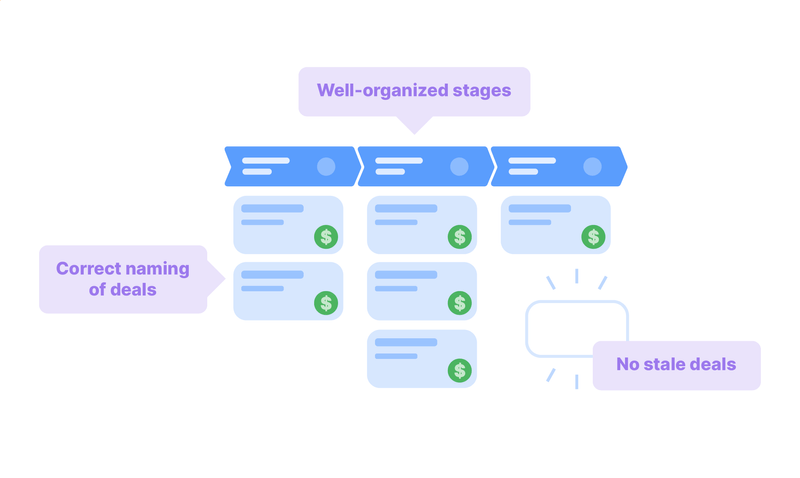
When doing a pipeline report, often, you might find that you need to move an opportunity backward; while it’s not common, it does happen. Perhaps, there has been a change in decision-maker, a company merger or restructure, and you need to move the business back into the qualifying stage. While a pipeline aims to keep flowing, it is better to move the opportunity back in the pipeline than to leave it in a stage it is not; this is as it will give you inaccurate information when it comes time to do your sales forecasting.
Use Data and Metrics To Refine Your Pipeline
One of the most useful things about a sales pipeline is that it collects data and metrics about your customer’s behaviors and your sales process’s success. This data and metrics will help you to tailor your processes to your prospects and opportunities needs, enabling you to get the best results from your sales team. Along with helping you tailor your sales process to your customer’s needs, metrics can help you progress towards goals, prepare for the company’s future growth, reward your sales team, and identify strategic issues. Data will help you to better understand, measure, and validate your pipeline, resulting in overall better results.
Sales Pipeline Metrics
Only you and your team can determine the ideal metrics for your business and its goals; like a sales pipeline, your metrics should be tailored to your company’s needs.
However, there are some standard metrics that we suggest that all businesses keep track of:
Deals In The Pipeline
One of the most important metrics is the total amount of deals in the pipeline, as it is enabling you to monitor all stages of your pipeline. It gives you an overview of how many new opportunities your marketing team is bringing in, how many deals your sales team are working on, and how many deals you are likely to close by the end of the sales cycle. If you notice that opportunities are struggling in one section of the pipeline, you can review the activities or allocate more resources.
Deal Size
Deal size enables you to use data from past closed deals to calculate the average size of the current deals and therefore forecast what revenue is coming in. Based on this information, your sales team should be able to understand the potential of the deal and accordingly prioritize those that are needed to reach your targets.
Win Rate
This refers to the number of deals that have been closed compared to the number of leads that have come through the pipeline. Not all leads that you get will make it to the qualifying stage, and then not all qualified leads will become paying customers. Knowing these metrics is key in understanding what is working and what isn’t, equipping you with the knowledge to improve your win rate.
Pipeline Velocity
Pipeline or deal velocity refers to the time that the deal sits in the pipeline before they are one. Statistically, the longer that a deal sits in the pipeline, the less likely you are to convert into a final sale. An increase in deal velocity helps you generate revenue at a faster rate and enables productivity to grow while using fewer resources.
Close More Deals With An Efficient Sales Pipeline
When it comes to sales, not one customer is the same, meaning that your sales pipeline needs to be able to cater to different customers’ expectations at various stages in the sales process. A comprehensive sales pipeline management system can help you visualize the number of open deals, the status of expected sales, and your sales team’s success rate. Through efficient management of your sales pipeline, you will accelerate your relationship building, automate sales processes, forecast more accurately, and ultimately close more deals.
